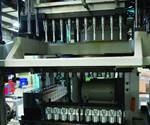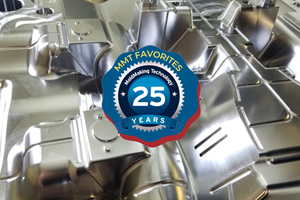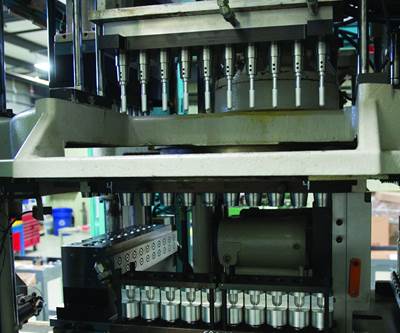A Conversation with SA Engineering
MMT interviews SA Engineering, a company that offers full-service engineering for the development of injection-molded products.
What do you believe is driving original equipment manufacturers (OEMs) to demand advanced technology solutions, new processes and mold innovations that many Tier 1 suppliers cannot offer?
Jim Osbourn, Site Manager: Advances in electric and high efficiency vehicle designs are increasing the need for process improvements and cost reduction, and that requires improved quality, cycle time and mass reduction. But, the industry has seen a drop in expertise. Journeymen moldmakers are retiring, and companies let go of qualified staff when the economy crashed in 2008. Because of that shortage in skill and experience, among other reasons, many OEMs are having a difficult time convincing their Tier 1 suppliers to use new technologies without first having another party like SA Engineering validate those technologies.
How does SA help molders and mold builders provide those solutions to their customers?
SA Engineering: We offer the technical rationalization and direction for the mold builder and molder to put advanced technologies, such as magnetic induction, high pressure hot water, saturated steam, nitrogen counter pressure and core back and MuCell into their tools. Each offers a strategic way to improve part cosmetics and to shorten cycle time. Additionally, each offers a way to reduce differential stress, mass and press clamp tonnage requirements.
Magnetic induction is one popular technology solution that SA provides. You stated that it is an added secondary feature to a mold. Can you briefly explain how it works and what it does?
SA Engineering: Magnetic induction creates an eddy current in the surface of the tool, which in turn creates resistance and heats very quickly (at a pace of 1°F per second). As a result, the heat can be increased momentarily, and that raises the tool’s surface to temperatures that exceed the capability of conventional thermolators, allowing improved material flow, less differential shrink and a more resin-rich surface. This improves part finish without increasing cycle time. Plus, it happens in a zone that eliminates or reduces cosmetic issues and improves finish and dimensional stability.
Provide details of a project that used magnetic induction. Share the problem, the solution and the results.
SA Engineering: One of our customers, who is a Tier 1 manufacturer of small, chrome-plated plastic parts, had an issue with a high-profile part for a Big Three customer. Our customer had a knit line around some lettering on a part that was impossible to eliminate using conventional methods like sequential valve gating, different gate locations and so on. We used magnetic induction to make the tool surface hotter than the original maximum mold temperature, which eliminated the knit lines. Ever since, that customer has fully committed to the technology and is having multiple power supplies/controllers and induction coils built. Another recent project involved a chrome-plated PC/ABS plastic part that had a cosmetic imperfection that a customer wanted to remove. It was possible to solve the problem through conventional process development, but the conventional method affected other aspects of part quality and performance. Materials that are typically injection-molded for chrome plating have internal stresses as a result of the injection molding fill process, gating and flow patterns. Mold builders routinely examine these materials after molding by performing a test called glacial acid etching, which demonstrates those stresses and the tightness of the part’s structure. Studies show that when the part has significant stress, it is typically more difficult to plate the part with chrome and then maintain that plating on the part throughout its lifetime. However, through past experiments and testing, our team noted that momentarily increasing temperatures on the mold’s A-side surface could lead to improved flow, a higher temperature flow front and the complete melding of materials as it wraps around part obstructions like logos and core buttons. Using advanced magnetic induction technology and state-of-the-art injection molding machines, we could eliminate the cosmetic flaw without compromising other features of the part. Additionally, because of improved flexibility and a larger processing window, we achieved shorter cycle times, differential stress reduction and improved chrome and paint adhesion on the part. Another advantage of this technology is lower press clamp tonnage requirements because of improved material flow.
What other technologies should moldmakers be keeping an eye out for and why?
SA Engineering: Anything variotherm, which is hot-cold technology that resolves cosmetic issues, improves part finish. On light-weighting technologies like MuCell, variotherm makes that technology viable on Class A parts, which would not be possible without it.
Can you describe a common request that customers have for SA that may represent an opportunity for mold builders? (For example, you mention Tier 1s wanting the entire process from one supplier, so moldmakers can offer that turnkey solution—including end of arm tooling, etc.—by working with SA.)
SA Engineering: Tier 1s and OEMs do not want to manage any entirely new technology and its integration with other technologies. They want the Tier 2 molders and moldmakers to offer the complete turnkey solution. The reasoning behind that is that resources in personnel and advanced technology are very difficult to obtain.
Related Content
Making Mentoring Work | MMT Chat Part 2
Three of the TK Mold and Engineering team in Romeo, Michigan join me for Part 2 of this MMT Chat on mentorship by sharing how the AMBA’s Meet a Mentor Program works, lessons learned (and applied) and the way your shop can join this effort.
Read MoreDynamic Tool Corporation – Creating the Team to Move Moldmaking Into the Future
For 40+ years, Dynamic Tool Corp. has offered precision tooling, emphasizing education, mentoring and innovation. The company is committed to excellence, integrity, safety and customer service, as well as inspiring growth and quality in manufacturing.
Read MoreHow to Use Scientific Maintenance for More Accurate Mold and Part Troubleshooting
Discover how adopting scientific maintenance approaches helps improve mold lifespan, minimize failures, and optimize production outcomes.
Read MoreLeading Mold Manufacturers Share Best Practices for Improving Efficiency
Precise Tooling Solutions, X-Cell Tool and Mold, M&M Tool and Mold, Ameritech Die & Mold, and Cavalier Tool & Manufacturing, sit down for a fast-paced Q&A focused on strategies for improving efficiencies across their operations.
Read MoreRead Next
A Conversation with Big 3 Precision Products Inc.
MMT interviews Big 3 Precision Products Inc., a group that builds injection blow molds, one- and two-step injection stretch blow molds and extrusion blow molds.
Read MoreAre You a Moldmaker Considering 3D Printing? Consider the 3D Printing Workshop at NPE2024
Presentations will cover 3D printing for mold tooling, material innovation, product development, bridge production and full-scale, high-volume additive manufacturing.
Read MoreHow to Use Continuing Education to Remain Competitive in Moldmaking
Continued training helps moldmakers make tooling decisions and properly use the latest cutting tool to efficiently machine high-quality molds.
Read More


















